Comprehensive Economic Report: Tax Impact, Cost and Market Structures
VerifiedAdded on 2023/06/12
|12
|2907
|493
Report
AI Summary
This economics assignment provides a detailed analysis of various economic concepts, starting with the impact of excise tax on tobacco products in Australia, focusing on price elasticity of demand and tax incidence. It further explores cost analysis, including fixed, variable, and marginal costs, to determine profit-maximizing output for a firm in a competitive market. The report differentiates between monopolistic competition and oligopoly market structures, highlighting key differences in market control, pricing strategies, and barriers to entry. Finally, it discusses the rationale behind mergers between state and local governments in Australia, emphasizing economies of scale and scope, increased efficiency, and improved service delivery. Desklib provides access to this assignment and other resources for students.
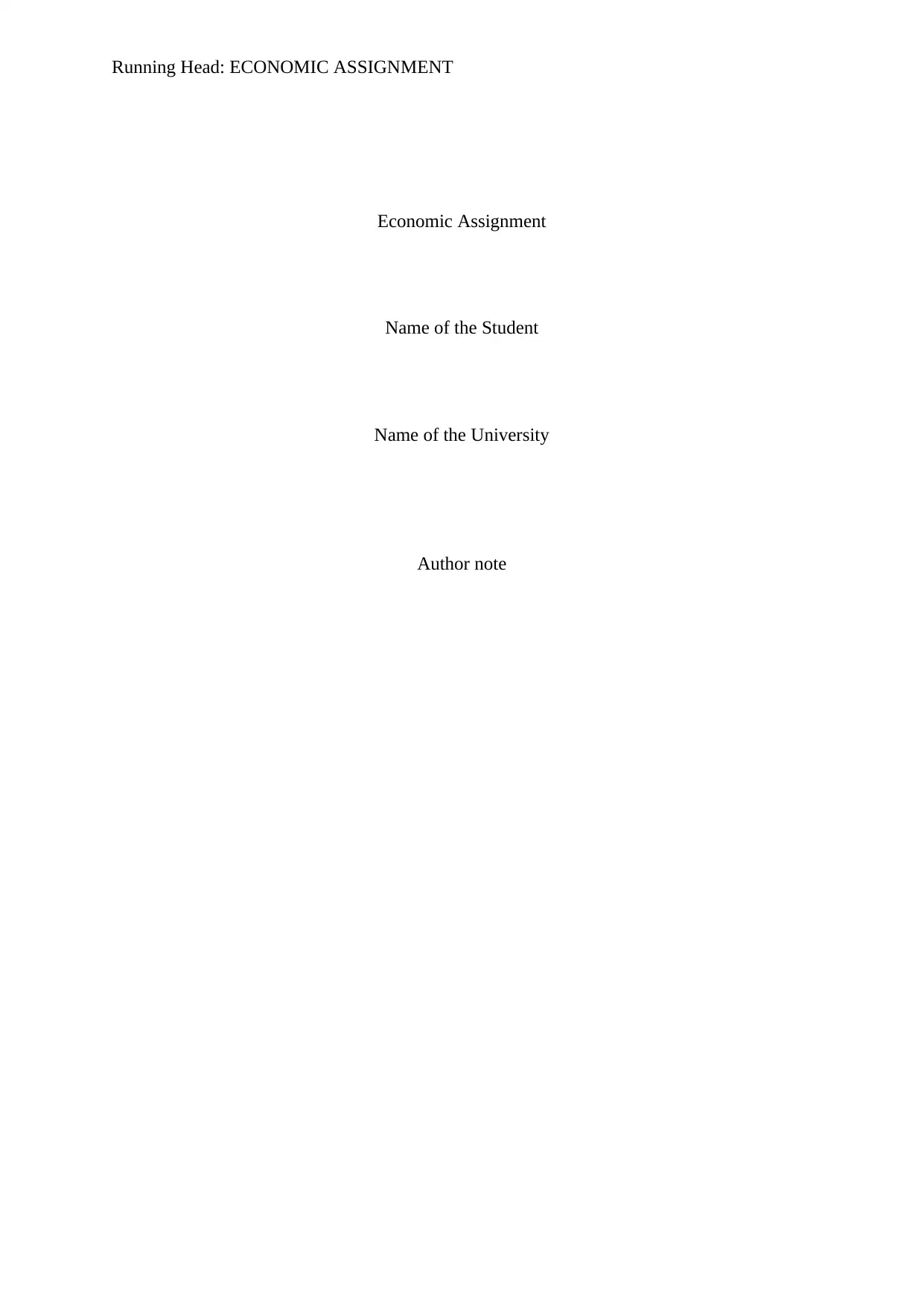
Running Head: ECONOMIC ASSIGNMENT
Economic Assignment
Name of the Student
Name of the University
Author note
Economic Assignment
Name of the Student
Name of the University
Author note
Paraphrase This Document
Need a fresh take? Get an instant paraphrase of this document with our AI Paraphraser
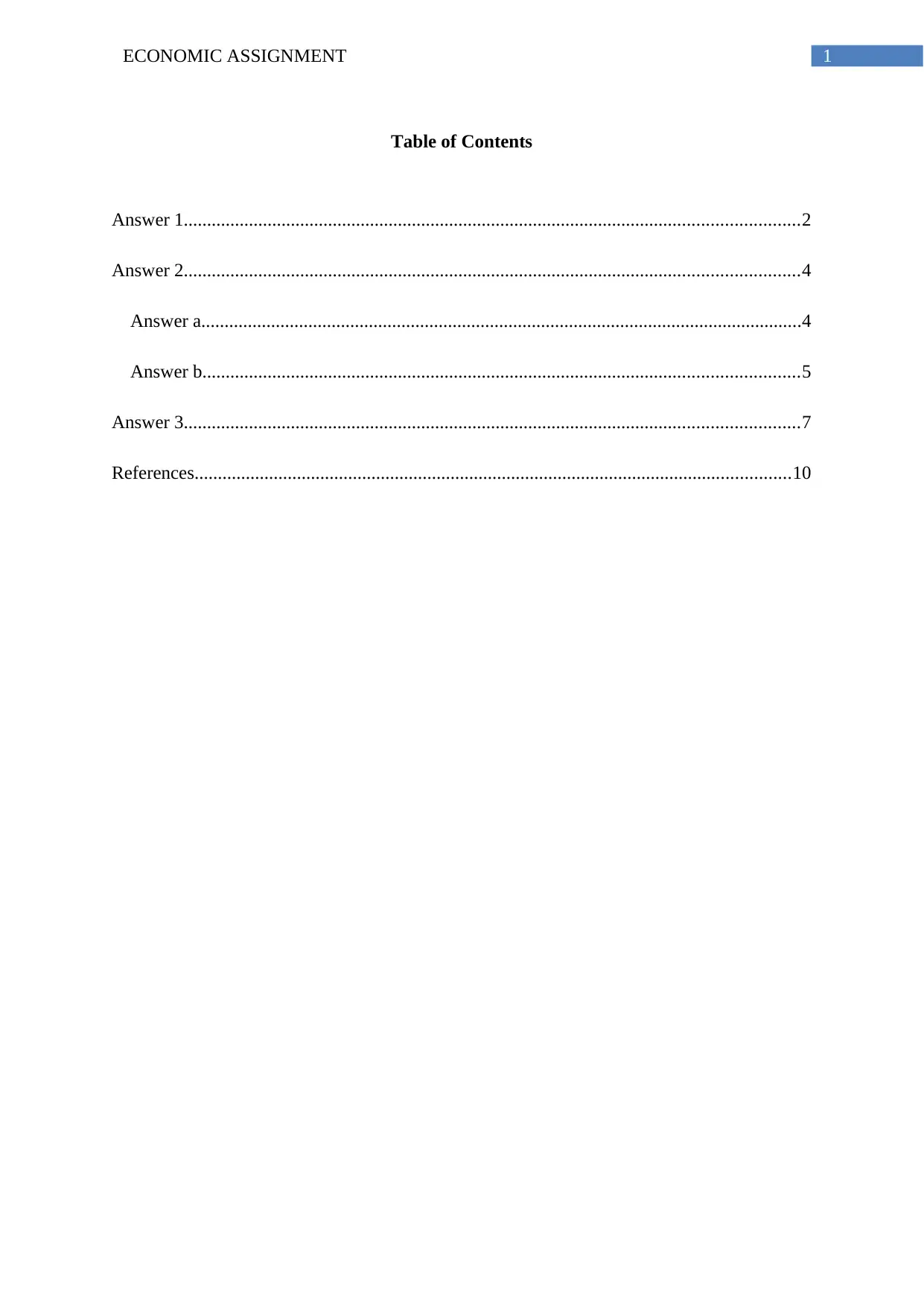
1ECONOMIC ASSIGNMENT
Table of Contents
Answer 1....................................................................................................................................2
Answer 2....................................................................................................................................4
Answer a.................................................................................................................................4
Answer b................................................................................................................................5
Answer 3....................................................................................................................................7
References................................................................................................................................10
Table of Contents
Answer 1....................................................................................................................................2
Answer 2....................................................................................................................................4
Answer a.................................................................................................................................4
Answer b................................................................................................................................5
Answer 3....................................................................................................................................7
References................................................................................................................................10
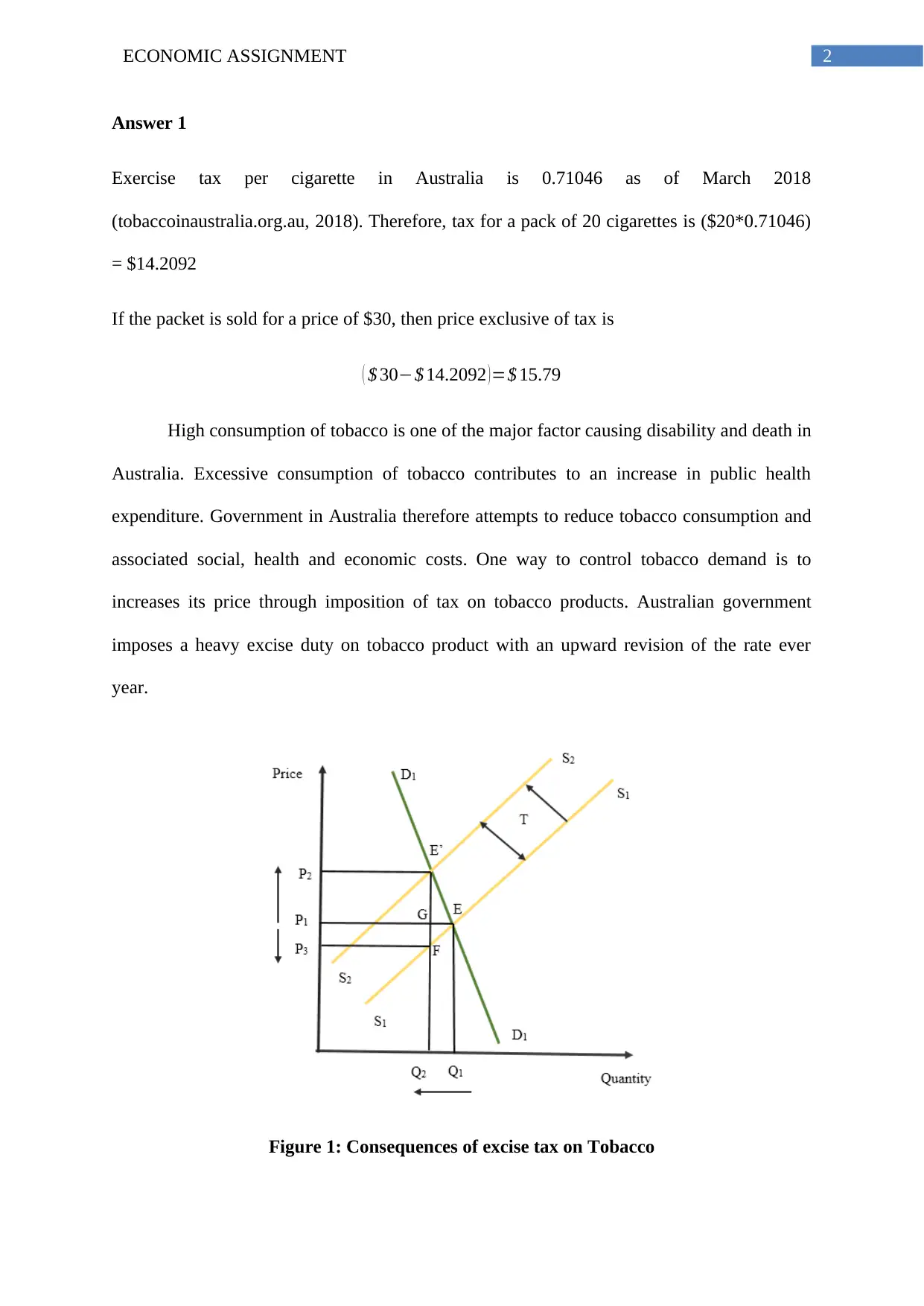
2ECONOMIC ASSIGNMENT
Answer 1
Exercise tax per cigarette in Australia is 0.71046 as of March 2018
(tobaccoinaustralia.org.au, 2018). Therefore, tax for a pack of 20 cigarettes is ($20*0.71046)
= $14.2092
If the packet is sold for a price of $30, then price exclusive of tax is
( $ 30−$ 14.2092 )=$ 15.79
High consumption of tobacco is one of the major factor causing disability and death in
Australia. Excessive consumption of tobacco contributes to an increase in public health
expenditure. Government in Australia therefore attempts to reduce tobacco consumption and
associated social, health and economic costs. One way to control tobacco demand is to
increases its price through imposition of tax on tobacco products. Australian government
imposes a heavy excise duty on tobacco product with an upward revision of the rate ever
year.
Figure 1: Consequences of excise tax on Tobacco
Answer 1
Exercise tax per cigarette in Australia is 0.71046 as of March 2018
(tobaccoinaustralia.org.au, 2018). Therefore, tax for a pack of 20 cigarettes is ($20*0.71046)
= $14.2092
If the packet is sold for a price of $30, then price exclusive of tax is
( $ 30−$ 14.2092 )=$ 15.79
High consumption of tobacco is one of the major factor causing disability and death in
Australia. Excessive consumption of tobacco contributes to an increase in public health
expenditure. Government in Australia therefore attempts to reduce tobacco consumption and
associated social, health and economic costs. One way to control tobacco demand is to
increases its price through imposition of tax on tobacco products. Australian government
imposes a heavy excise duty on tobacco product with an upward revision of the rate ever
year.
Figure 1: Consequences of excise tax on Tobacco
⊘ This is a preview!⊘
Do you want full access?
Subscribe today to unlock all pages.

Trusted by 1+ million students worldwide
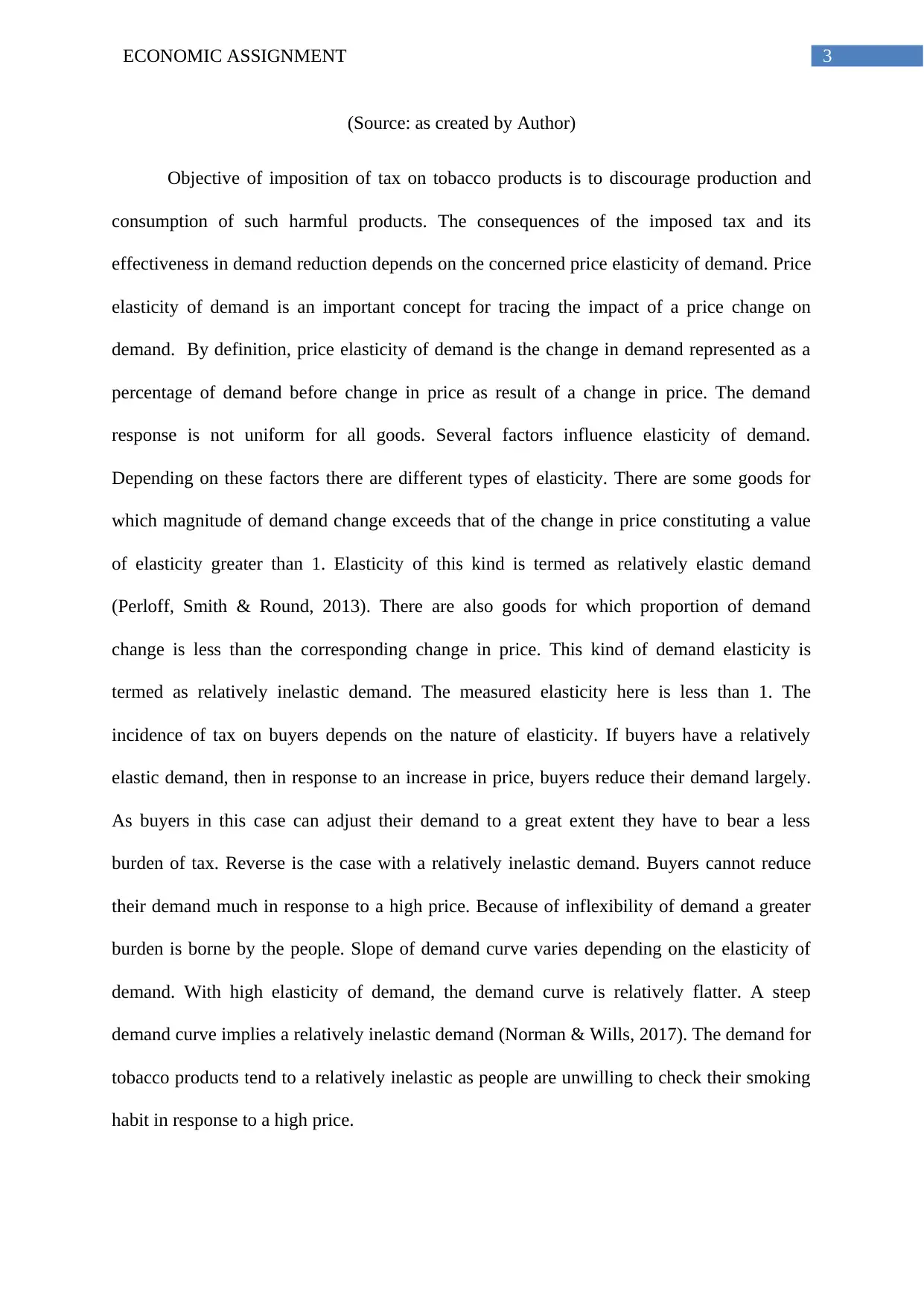
3ECONOMIC ASSIGNMENT
(Source: as created by Author)
Objective of imposition of tax on tobacco products is to discourage production and
consumption of such harmful products. The consequences of the imposed tax and its
effectiveness in demand reduction depends on the concerned price elasticity of demand. Price
elasticity of demand is an important concept for tracing the impact of a price change on
demand. By definition, price elasticity of demand is the change in demand represented as a
percentage of demand before change in price as result of a change in price. The demand
response is not uniform for all goods. Several factors influence elasticity of demand.
Depending on these factors there are different types of elasticity. There are some goods for
which magnitude of demand change exceeds that of the change in price constituting a value
of elasticity greater than 1. Elasticity of this kind is termed as relatively elastic demand
(Perloff, Smith & Round, 2013). There are also goods for which proportion of demand
change is less than the corresponding change in price. This kind of demand elasticity is
termed as relatively inelastic demand. The measured elasticity here is less than 1. The
incidence of tax on buyers depends on the nature of elasticity. If buyers have a relatively
elastic demand, then in response to an increase in price, buyers reduce their demand largely.
As buyers in this case can adjust their demand to a great extent they have to bear a less
burden of tax. Reverse is the case with a relatively inelastic demand. Buyers cannot reduce
their demand much in response to a high price. Because of inflexibility of demand a greater
burden is borne by the people. Slope of demand curve varies depending on the elasticity of
demand. With high elasticity of demand, the demand curve is relatively flatter. A steep
demand curve implies a relatively inelastic demand (Norman & Wills, 2017). The demand for
tobacco products tend to a relatively inelastic as people are unwilling to check their smoking
habit in response to a high price.
(Source: as created by Author)
Objective of imposition of tax on tobacco products is to discourage production and
consumption of such harmful products. The consequences of the imposed tax and its
effectiveness in demand reduction depends on the concerned price elasticity of demand. Price
elasticity of demand is an important concept for tracing the impact of a price change on
demand. By definition, price elasticity of demand is the change in demand represented as a
percentage of demand before change in price as result of a change in price. The demand
response is not uniform for all goods. Several factors influence elasticity of demand.
Depending on these factors there are different types of elasticity. There are some goods for
which magnitude of demand change exceeds that of the change in price constituting a value
of elasticity greater than 1. Elasticity of this kind is termed as relatively elastic demand
(Perloff, Smith & Round, 2013). There are also goods for which proportion of demand
change is less than the corresponding change in price. This kind of demand elasticity is
termed as relatively inelastic demand. The measured elasticity here is less than 1. The
incidence of tax on buyers depends on the nature of elasticity. If buyers have a relatively
elastic demand, then in response to an increase in price, buyers reduce their demand largely.
As buyers in this case can adjust their demand to a great extent they have to bear a less
burden of tax. Reverse is the case with a relatively inelastic demand. Buyers cannot reduce
their demand much in response to a high price. Because of inflexibility of demand a greater
burden is borne by the people. Slope of demand curve varies depending on the elasticity of
demand. With high elasticity of demand, the demand curve is relatively flatter. A steep
demand curve implies a relatively inelastic demand (Norman & Wills, 2017). The demand for
tobacco products tend to a relatively inelastic as people are unwilling to check their smoking
habit in response to a high price.
Paraphrase This Document
Need a fresh take? Get an instant paraphrase of this document with our AI Paraphraser
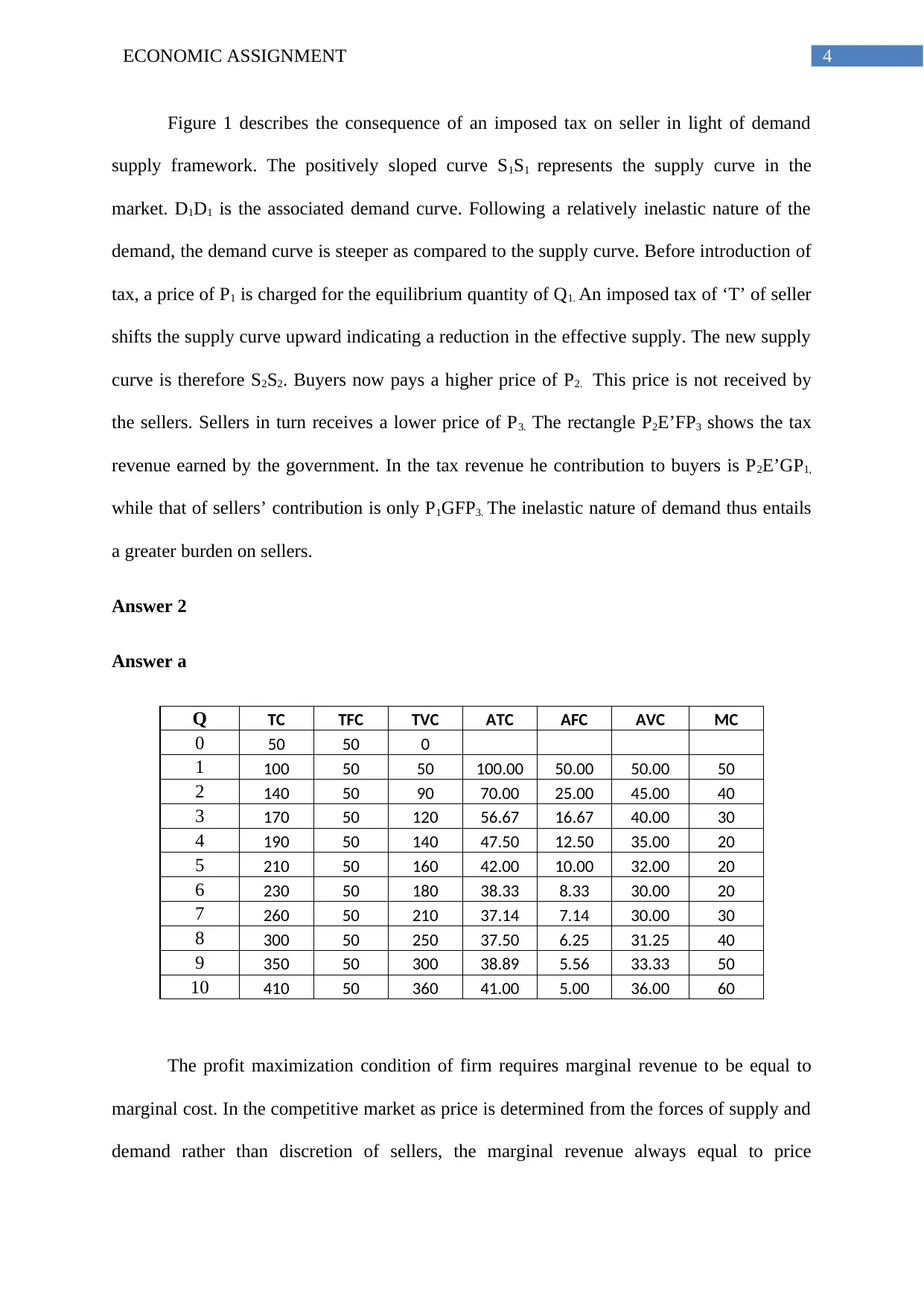
4ECONOMIC ASSIGNMENT
Figure 1 describes the consequence of an imposed tax on seller in light of demand
supply framework. The positively sloped curve S1S1 represents the supply curve in the
market. D1D1 is the associated demand curve. Following a relatively inelastic nature of the
demand, the demand curve is steeper as compared to the supply curve. Before introduction of
tax, a price of P1 is charged for the equilibrium quantity of Q1. An imposed tax of ‘T’ of seller
shifts the supply curve upward indicating a reduction in the effective supply. The new supply
curve is therefore S2S2. Buyers now pays a higher price of P2. This price is not received by
the sellers. Sellers in turn receives a lower price of P3. The rectangle P2E’FP3 shows the tax
revenue earned by the government. In the tax revenue he contribution to buyers is P2E’GP1,
while that of sellers’ contribution is only P1GFP3. The inelastic nature of demand thus entails
a greater burden on sellers.
Answer 2
Answer a
Q TC TFC TVC ATC AFC AVC MC
0 50 50 0
1 100 50 50 100.00 50.00 50.00 50
2 140 50 90 70.00 25.00 45.00 40
3 170 50 120 56.67 16.67 40.00 30
4 190 50 140 47.50 12.50 35.00 20
5 210 50 160 42.00 10.00 32.00 20
6 230 50 180 38.33 8.33 30.00 20
7 260 50 210 37.14 7.14 30.00 30
8 300 50 250 37.50 6.25 31.25 40
9 350 50 300 38.89 5.56 33.33 50
10 410 50 360 41.00 5.00 36.00 60
The profit maximization condition of firm requires marginal revenue to be equal to
marginal cost. In the competitive market as price is determined from the forces of supply and
demand rather than discretion of sellers, the marginal revenue always equal to price
Figure 1 describes the consequence of an imposed tax on seller in light of demand
supply framework. The positively sloped curve S1S1 represents the supply curve in the
market. D1D1 is the associated demand curve. Following a relatively inelastic nature of the
demand, the demand curve is steeper as compared to the supply curve. Before introduction of
tax, a price of P1 is charged for the equilibrium quantity of Q1. An imposed tax of ‘T’ of seller
shifts the supply curve upward indicating a reduction in the effective supply. The new supply
curve is therefore S2S2. Buyers now pays a higher price of P2. This price is not received by
the sellers. Sellers in turn receives a lower price of P3. The rectangle P2E’FP3 shows the tax
revenue earned by the government. In the tax revenue he contribution to buyers is P2E’GP1,
while that of sellers’ contribution is only P1GFP3. The inelastic nature of demand thus entails
a greater burden on sellers.
Answer 2
Answer a
Q TC TFC TVC ATC AFC AVC MC
0 50 50 0
1 100 50 50 100.00 50.00 50.00 50
2 140 50 90 70.00 25.00 45.00 40
3 170 50 120 56.67 16.67 40.00 30
4 190 50 140 47.50 12.50 35.00 20
5 210 50 160 42.00 10.00 32.00 20
6 230 50 180 38.33 8.33 30.00 20
7 260 50 210 37.14 7.14 30.00 30
8 300 50 250 37.50 6.25 31.25 40
9 350 50 300 38.89 5.56 33.33 50
10 410 50 360 41.00 5.00 36.00 60
The profit maximization condition of firm requires marginal revenue to be equal to
marginal cost. In the competitive market as price is determined from the forces of supply and
demand rather than discretion of sellers, the marginal revenue always equal to price

5ECONOMIC ASSIGNMENT
(Waldman & Jensen, 2016). Therefore, profit maximization condition in the short run
reduced to Price = Marginal cost. From the estimated cost table, it is evident that given price
of $35 lies between a marginal cost of 30 and 40. The output thus lies between 7 and 8.
Approximately 7.5 units will be produced in the short run.
The competitive market equilibrium condition in the long run requires that price is set
at the minimum of average total cost. In the short run price in lower than minimum average
cost of 37.14. The price though lower than total average cost but is higher than minimum of
average variable cost 30. For this, the firm though incurs a loss in the short run but still
continues production (Waldman & Jensen, 2016). The scenario however in different in the
long run. In the long run the loss making firm exit the industry as price remain below the
minimum of total average cost.
Answer b
In terms of economics market represents an exchange relation between a single or
group of buyers and sellers. The number of sellers in the market determines the degree of
competition in the market. A perfectly competitive market is one where various buyers and
sellers are present in the market and seller sell a homogenous good. In reality however no
market is perfectly competitive (Sergienko, Mikhalevich & Koshlai, 2014). Some common
form of imperfect competition is monopoly, oligopoly and monopolistic competition.
Oligopoly and monopolistic competition are the two forms of imperfectly competitive
markets found to exist in different countries.
Monopolistic competition
The monopolistic competition is a kind of imperfect competition where several
producers in the market sell a differentiated product. Because of product differentiation, the
products are not perfect substitutes. Each firm in the market takes own decision regarding
(Waldman & Jensen, 2016). Therefore, profit maximization condition in the short run
reduced to Price = Marginal cost. From the estimated cost table, it is evident that given price
of $35 lies between a marginal cost of 30 and 40. The output thus lies between 7 and 8.
Approximately 7.5 units will be produced in the short run.
The competitive market equilibrium condition in the long run requires that price is set
at the minimum of average total cost. In the short run price in lower than minimum average
cost of 37.14. The price though lower than total average cost but is higher than minimum of
average variable cost 30. For this, the firm though incurs a loss in the short run but still
continues production (Waldman & Jensen, 2016). The scenario however in different in the
long run. In the long run the loss making firm exit the industry as price remain below the
minimum of total average cost.
Answer b
In terms of economics market represents an exchange relation between a single or
group of buyers and sellers. The number of sellers in the market determines the degree of
competition in the market. A perfectly competitive market is one where various buyers and
sellers are present in the market and seller sell a homogenous good. In reality however no
market is perfectly competitive (Sergienko, Mikhalevich & Koshlai, 2014). Some common
form of imperfect competition is monopoly, oligopoly and monopolistic competition.
Oligopoly and monopolistic competition are the two forms of imperfectly competitive
markets found to exist in different countries.
Monopolistic competition
The monopolistic competition is a kind of imperfect competition where several
producers in the market sell a differentiated product. Because of product differentiation, the
products are not perfect substitutes. Each firm in the market takes own decision regarding
⊘ This is a preview!⊘
Do you want full access?
Subscribe today to unlock all pages.

Trusted by 1+ million students worldwide

6ECONOMIC ASSIGNMENT
price and output keeping in mind prices charged by its competitors and cost of production
(Fine, 2016). There is though large flow of information in the market but still the market
lacks complete set of information like perfectly competitively market. Grocery market, coffee
shops, hotels, automobile services are some examples of monopolistically competitive
market.
Oligopoly
The name oligopoly is derived from two Greek words, ‘Oligo’ meaning few and
‘Polein’ means sell. The oligopoly market thus refers to market where a few sellers engage in
selling a homogenous or differentiated product. In case of homogenous product, it is called
pure oligopoly while oligopoly market with differentiated product is called differentiated
oligopoly (Nikaido, 2015). Airlines, petroleum industry, supermarkets, telecommunication
industry generally have an oligopolistic market structure.
Some major point of differences between oligopoly and monopolistic competition is given as
follows
Relative size of the market and market control is an important factor differentiating
oligopoly and monopolistically competitive market. Oligopoly market is smaller than the
monopolistically competitive market. The few large seller in the market in the market thus
have a greater control over price and enjoy a greater market power (Baiardi, Lamantia &
Radi, 2015). In monopolistically competitive market large number of small sized firms have
only a small market share and thus cannot influence market price.
Firms in an oligopoly market faces a kinked demand curve. The kinked demand curve
has implication for price competition. When one firm reduces its price, its rival firms do the
same. This leads to a price war among the firms present in the market. In Australia,
Woolworth and Coles are the two dominating players in the grocery supermarket. If any one
price and output keeping in mind prices charged by its competitors and cost of production
(Fine, 2016). There is though large flow of information in the market but still the market
lacks complete set of information like perfectly competitively market. Grocery market, coffee
shops, hotels, automobile services are some examples of monopolistically competitive
market.
Oligopoly
The name oligopoly is derived from two Greek words, ‘Oligo’ meaning few and
‘Polein’ means sell. The oligopoly market thus refers to market where a few sellers engage in
selling a homogenous or differentiated product. In case of homogenous product, it is called
pure oligopoly while oligopoly market with differentiated product is called differentiated
oligopoly (Nikaido, 2015). Airlines, petroleum industry, supermarkets, telecommunication
industry generally have an oligopolistic market structure.
Some major point of differences between oligopoly and monopolistic competition is given as
follows
Relative size of the market and market control is an important factor differentiating
oligopoly and monopolistically competitive market. Oligopoly market is smaller than the
monopolistically competitive market. The few large seller in the market in the market thus
have a greater control over price and enjoy a greater market power (Baiardi, Lamantia &
Radi, 2015). In monopolistically competitive market large number of small sized firms have
only a small market share and thus cannot influence market price.
Firms in an oligopoly market faces a kinked demand curve. The kinked demand curve
has implication for price competition. When one firm reduces its price, its rival firms do the
same. This leads to a price war among the firms present in the market. In Australia,
Woolworth and Coles are the two dominating players in the grocery supermarket. If any one
Paraphrase This Document
Need a fresh take? Get an instant paraphrase of this document with our AI Paraphraser
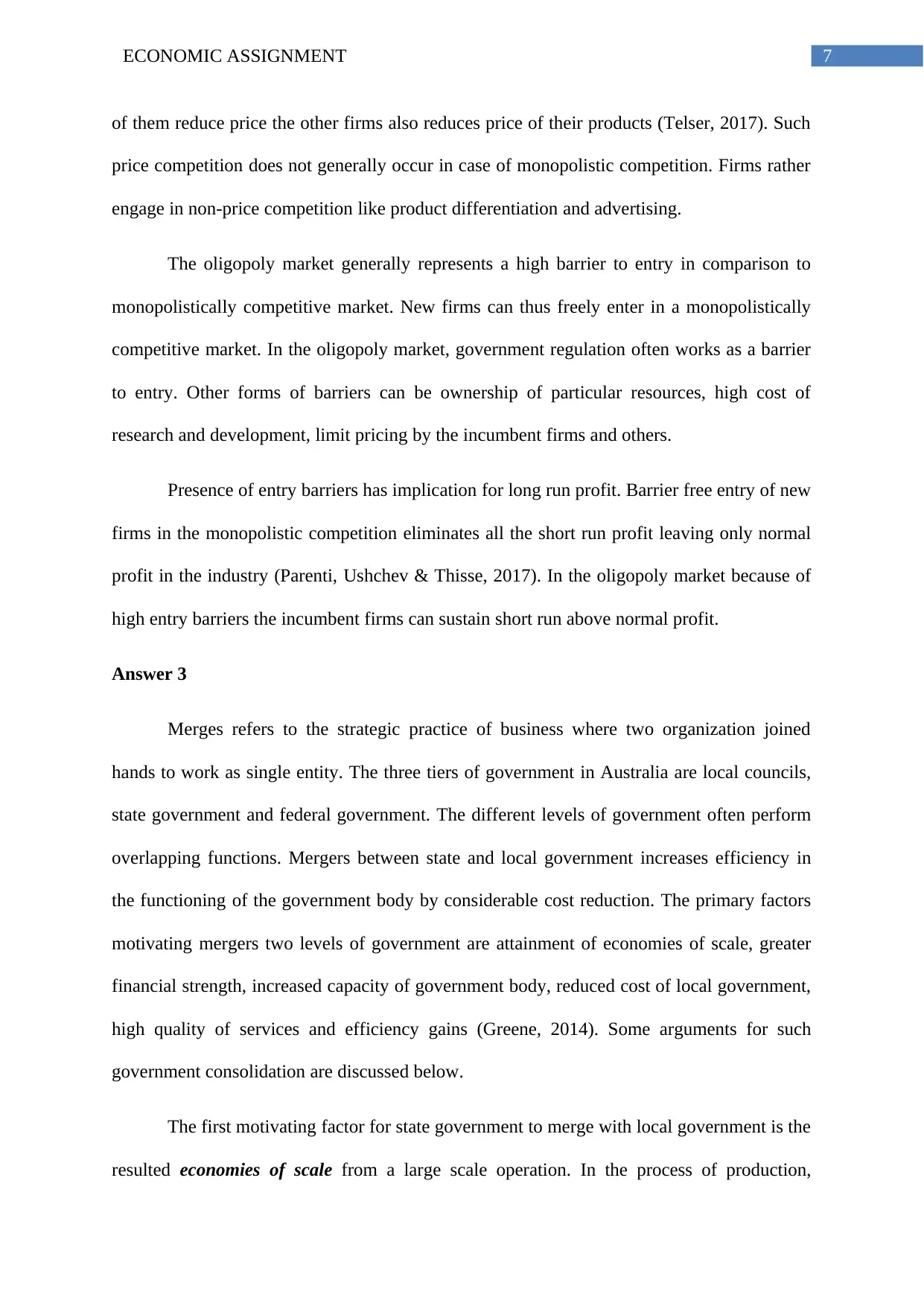
7ECONOMIC ASSIGNMENT
of them reduce price the other firms also reduces price of their products (Telser, 2017). Such
price competition does not generally occur in case of monopolistic competition. Firms rather
engage in non-price competition like product differentiation and advertising.
The oligopoly market generally represents a high barrier to entry in comparison to
monopolistically competitive market. New firms can thus freely enter in a monopolistically
competitive market. In the oligopoly market, government regulation often works as a barrier
to entry. Other forms of barriers can be ownership of particular resources, high cost of
research and development, limit pricing by the incumbent firms and others.
Presence of entry barriers has implication for long run profit. Barrier free entry of new
firms in the monopolistic competition eliminates all the short run profit leaving only normal
profit in the industry (Parenti, Ushchev & Thisse, 2017). In the oligopoly market because of
high entry barriers the incumbent firms can sustain short run above normal profit.
Answer 3
Merges refers to the strategic practice of business where two organization joined
hands to work as single entity. The three tiers of government in Australia are local councils,
state government and federal government. The different levels of government often perform
overlapping functions. Mergers between state and local government increases efficiency in
the functioning of the government body by considerable cost reduction. The primary factors
motivating mergers two levels of government are attainment of economies of scale, greater
financial strength, increased capacity of government body, reduced cost of local government,
high quality of services and efficiency gains (Greene, 2014). Some arguments for such
government consolidation are discussed below.
The first motivating factor for state government to merge with local government is the
resulted economies of scale from a large scale operation. In the process of production,
of them reduce price the other firms also reduces price of their products (Telser, 2017). Such
price competition does not generally occur in case of monopolistic competition. Firms rather
engage in non-price competition like product differentiation and advertising.
The oligopoly market generally represents a high barrier to entry in comparison to
monopolistically competitive market. New firms can thus freely enter in a monopolistically
competitive market. In the oligopoly market, government regulation often works as a barrier
to entry. Other forms of barriers can be ownership of particular resources, high cost of
research and development, limit pricing by the incumbent firms and others.
Presence of entry barriers has implication for long run profit. Barrier free entry of new
firms in the monopolistic competition eliminates all the short run profit leaving only normal
profit in the industry (Parenti, Ushchev & Thisse, 2017). In the oligopoly market because of
high entry barriers the incumbent firms can sustain short run above normal profit.
Answer 3
Merges refers to the strategic practice of business where two organization joined
hands to work as single entity. The three tiers of government in Australia are local councils,
state government and federal government. The different levels of government often perform
overlapping functions. Mergers between state and local government increases efficiency in
the functioning of the government body by considerable cost reduction. The primary factors
motivating mergers two levels of government are attainment of economies of scale, greater
financial strength, increased capacity of government body, reduced cost of local government,
high quality of services and efficiency gains (Greene, 2014). Some arguments for such
government consolidation are discussed below.
The first motivating factor for state government to merge with local government is the
resulted economies of scale from a large scale operation. In the process of production,
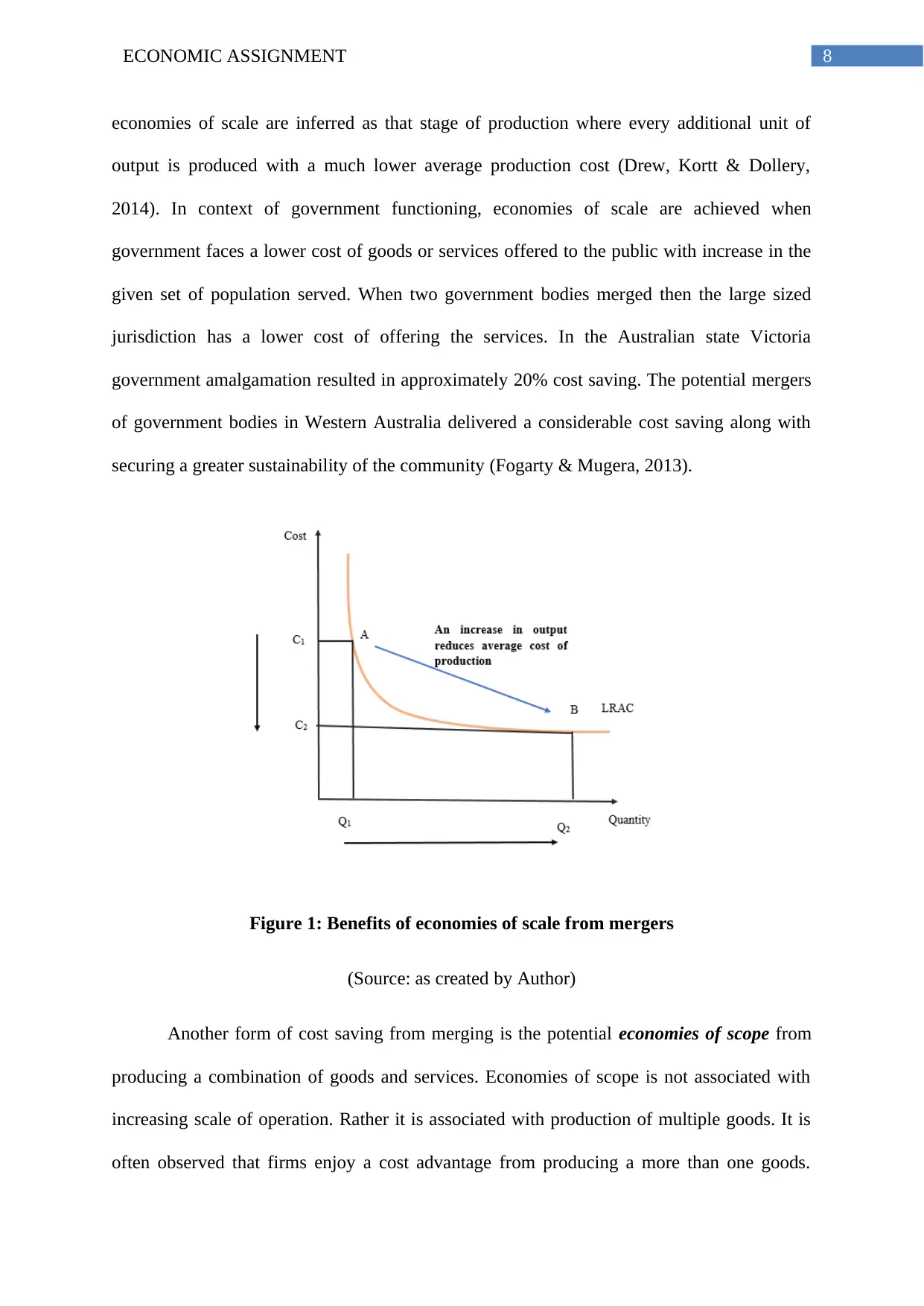
8ECONOMIC ASSIGNMENT
economies of scale are inferred as that stage of production where every additional unit of
output is produced with a much lower average production cost (Drew, Kortt & Dollery,
2014). In context of government functioning, economies of scale are achieved when
government faces a lower cost of goods or services offered to the public with increase in the
given set of population served. When two government bodies merged then the large sized
jurisdiction has a lower cost of offering the services. In the Australian state Victoria
government amalgamation resulted in approximately 20% cost saving. The potential mergers
of government bodies in Western Australia delivered a considerable cost saving along with
securing a greater sustainability of the community (Fogarty & Mugera, 2013).
Figure 1: Benefits of economies of scale from mergers
(Source: as created by Author)
Another form of cost saving from merging is the potential economies of scope from
producing a combination of goods and services. Economies of scope is not associated with
increasing scale of operation. Rather it is associated with production of multiple goods. It is
often observed that firms enjoy a cost advantage from producing a more than one goods.
economies of scale are inferred as that stage of production where every additional unit of
output is produced with a much lower average production cost (Drew, Kortt & Dollery,
2014). In context of government functioning, economies of scale are achieved when
government faces a lower cost of goods or services offered to the public with increase in the
given set of population served. When two government bodies merged then the large sized
jurisdiction has a lower cost of offering the services. In the Australian state Victoria
government amalgamation resulted in approximately 20% cost saving. The potential mergers
of government bodies in Western Australia delivered a considerable cost saving along with
securing a greater sustainability of the community (Fogarty & Mugera, 2013).
Figure 1: Benefits of economies of scale from mergers
(Source: as created by Author)
Another form of cost saving from merging is the potential economies of scope from
producing a combination of goods and services. Economies of scope is not associated with
increasing scale of operation. Rather it is associated with production of multiple goods. It is
often observed that firms enjoy a cost advantage from producing a more than one goods.
⊘ This is a preview!⊘
Do you want full access?
Subscribe today to unlock all pages.

Trusted by 1+ million students worldwide
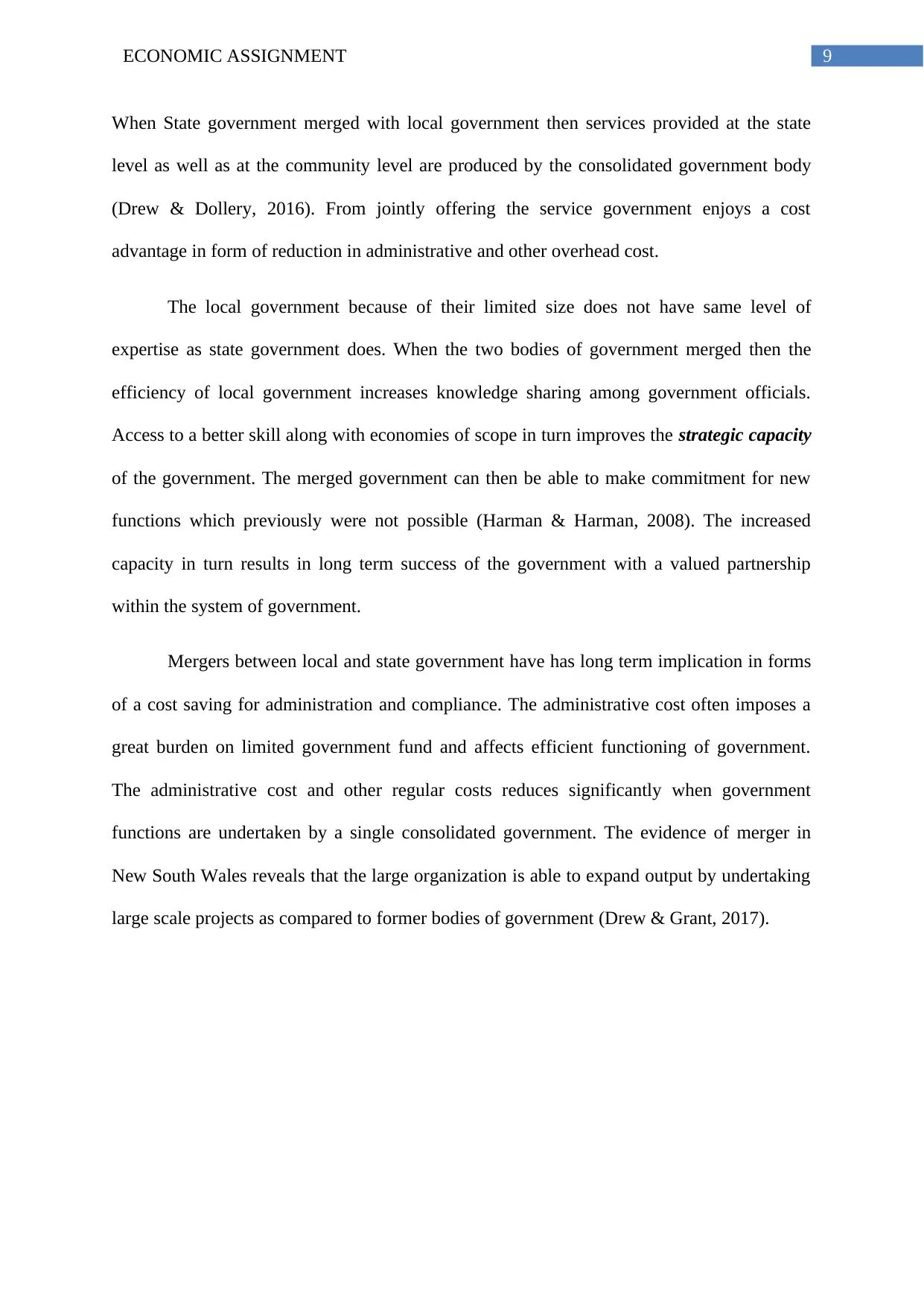
9ECONOMIC ASSIGNMENT
When State government merged with local government then services provided at the state
level as well as at the community level are produced by the consolidated government body
(Drew & Dollery, 2016). From jointly offering the service government enjoys a cost
advantage in form of reduction in administrative and other overhead cost.
The local government because of their limited size does not have same level of
expertise as state government does. When the two bodies of government merged then the
efficiency of local government increases knowledge sharing among government officials.
Access to a better skill along with economies of scope in turn improves the strategic capacity
of the government. The merged government can then be able to make commitment for new
functions which previously were not possible (Harman & Harman, 2008). The increased
capacity in turn results in long term success of the government with a valued partnership
within the system of government.
Mergers between local and state government have has long term implication in forms
of a cost saving for administration and compliance. The administrative cost often imposes a
great burden on limited government fund and affects efficient functioning of government.
The administrative cost and other regular costs reduces significantly when government
functions are undertaken by a single consolidated government. The evidence of merger in
New South Wales reveals that the large organization is able to expand output by undertaking
large scale projects as compared to former bodies of government (Drew & Grant, 2017).
When State government merged with local government then services provided at the state
level as well as at the community level are produced by the consolidated government body
(Drew & Dollery, 2016). From jointly offering the service government enjoys a cost
advantage in form of reduction in administrative and other overhead cost.
The local government because of their limited size does not have same level of
expertise as state government does. When the two bodies of government merged then the
efficiency of local government increases knowledge sharing among government officials.
Access to a better skill along with economies of scope in turn improves the strategic capacity
of the government. The merged government can then be able to make commitment for new
functions which previously were not possible (Harman & Harman, 2008). The increased
capacity in turn results in long term success of the government with a valued partnership
within the system of government.
Mergers between local and state government have has long term implication in forms
of a cost saving for administration and compliance. The administrative cost often imposes a
great burden on limited government fund and affects efficient functioning of government.
The administrative cost and other regular costs reduces significantly when government
functions are undertaken by a single consolidated government. The evidence of merger in
New South Wales reveals that the large organization is able to expand output by undertaking
large scale projects as compared to former bodies of government (Drew & Grant, 2017).
Paraphrase This Document
Need a fresh take? Get an instant paraphrase of this document with our AI Paraphraser

10ECONOMIC ASSIGNMENT
References
Baiardi, L. C., Lamantia, F., & Radi, D. (2015). Evolutionary competition between
boundedly rational behavioral rules in oligopoly games. Chaos, Solitons &
Fractals, 79, 204-225.
Drew, J., & Dollery, B. (2016). Less Haste, More Speed: The Fit for the Future Reform
Program in New South Wales Local Government. Australian Journal of Public
Administration, 75(1), 78-88.
Drew, J., & Grant, B. (2017). Multiple agents, blame games and public policy-making: The
case of local government reform in New South Wales. Australian Journal of Political
Science, 52(1), 37-52.
Drew, J., Kortt, M. A., & Dollery, B. (2014). Economies of scale and local government
expenditure: evidence from Australia. Administration & Society, 46(6), 632-653.
Fine, B. (2016). Microeconomics. University of Chicago Press Economics Books.
Fogarty, J., & Mugera, A. (2013). Local Government Efficiency: Evidence from Western
Australia. Australian Economic Review, 46(3), 300-311.
http://dx.doi.org/10.1111/j.1467-8462.2013.12015.x
Greene, R. (2014). Effective Rewards Strategies for Mergers, Acquisitions and Joint
Ventures/Alliances. Compensation & Benefits Review, 46(5-6), 287-291.
http://dx.doi.org/10.1177/0886368714565061
Harman, G., & Harman, K. (2008). Strategic mergers of strong institutions to enhance
competitive advantage. Higher Education Policy, 21(1), 99-121.
Nikaido, H. (2015). Monopolistic Competition and Effective Demand.(PSME-6). Princeton
University Press.
References
Baiardi, L. C., Lamantia, F., & Radi, D. (2015). Evolutionary competition between
boundedly rational behavioral rules in oligopoly games. Chaos, Solitons &
Fractals, 79, 204-225.
Drew, J., & Dollery, B. (2016). Less Haste, More Speed: The Fit for the Future Reform
Program in New South Wales Local Government. Australian Journal of Public
Administration, 75(1), 78-88.
Drew, J., & Grant, B. (2017). Multiple agents, blame games and public policy-making: The
case of local government reform in New South Wales. Australian Journal of Political
Science, 52(1), 37-52.
Drew, J., Kortt, M. A., & Dollery, B. (2014). Economies of scale and local government
expenditure: evidence from Australia. Administration & Society, 46(6), 632-653.
Fine, B. (2016). Microeconomics. University of Chicago Press Economics Books.
Fogarty, J., & Mugera, A. (2013). Local Government Efficiency: Evidence from Western
Australia. Australian Economic Review, 46(3), 300-311.
http://dx.doi.org/10.1111/j.1467-8462.2013.12015.x
Greene, R. (2014). Effective Rewards Strategies for Mergers, Acquisitions and Joint
Ventures/Alliances. Compensation & Benefits Review, 46(5-6), 287-291.
http://dx.doi.org/10.1177/0886368714565061
Harman, G., & Harman, K. (2008). Strategic mergers of strong institutions to enhance
competitive advantage. Higher Education Policy, 21(1), 99-121.
Nikaido, H. (2015). Monopolistic Competition and Effective Demand.(PSME-6). Princeton
University Press.
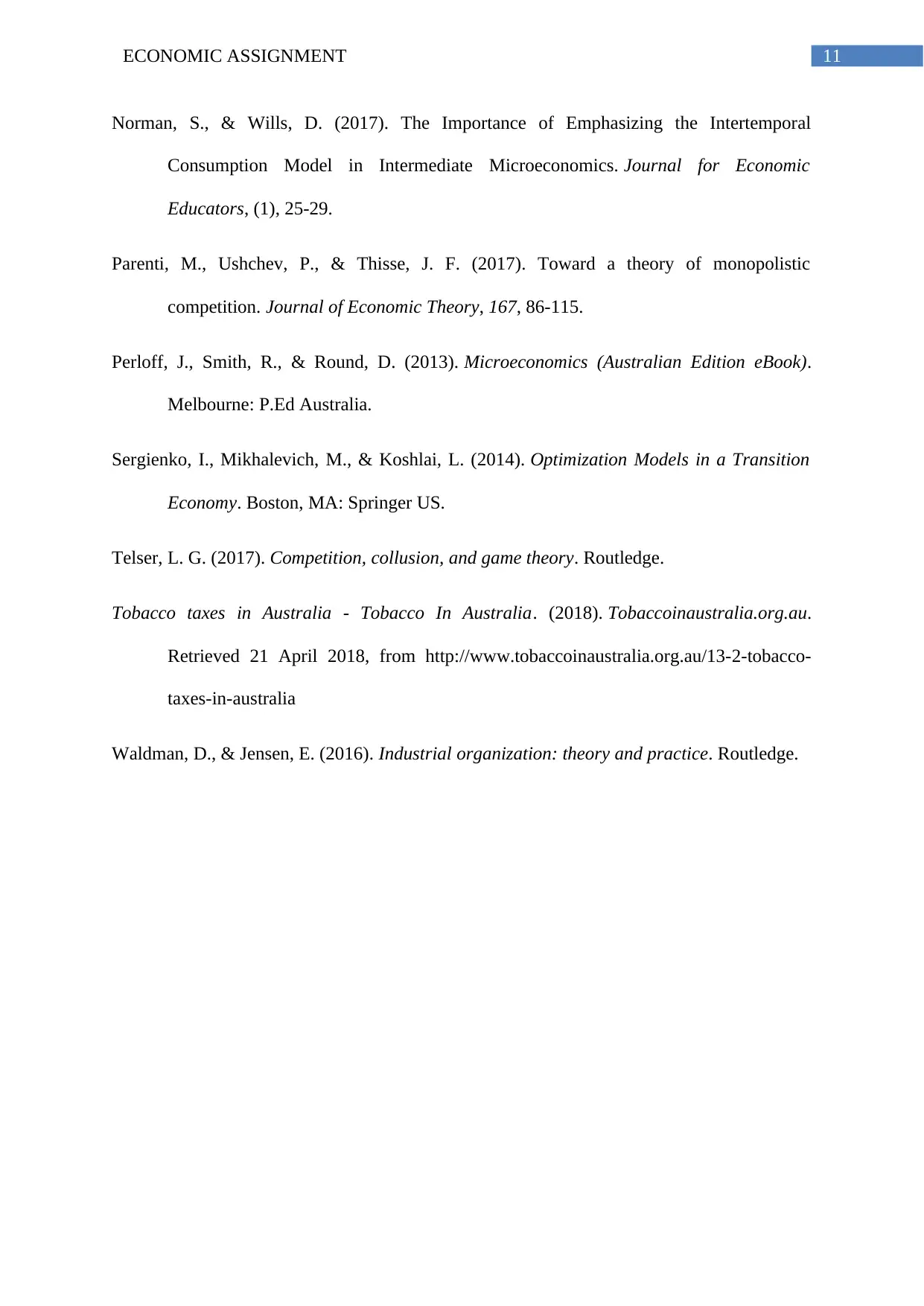
11ECONOMIC ASSIGNMENT
Norman, S., & Wills, D. (2017). The Importance of Emphasizing the Intertemporal
Consumption Model in Intermediate Microeconomics. Journal for Economic
Educators, (1), 25-29.
Parenti, M., Ushchev, P., & Thisse, J. F. (2017). Toward a theory of monopolistic
competition. Journal of Economic Theory, 167, 86-115.
Perloff, J., Smith, R., & Round, D. (2013). Microeconomics (Australian Edition eBook).
Melbourne: P.Ed Australia.
Sergienko, I., Mikhalevich, M., & Koshlai, L. (2014). Optimization Models in a Transition
Economy. Boston, MA: Springer US.
Telser, L. G. (2017). Competition, collusion, and game theory. Routledge.
Tobacco taxes in Australia - Tobacco In Australia. (2018). Tobaccoinaustralia.org.au.
Retrieved 21 April 2018, from http://www.tobaccoinaustralia.org.au/13-2-tobacco-
taxes-in-australia
Waldman, D., & Jensen, E. (2016). Industrial organization: theory and practice. Routledge.
Norman, S., & Wills, D. (2017). The Importance of Emphasizing the Intertemporal
Consumption Model in Intermediate Microeconomics. Journal for Economic
Educators, (1), 25-29.
Parenti, M., Ushchev, P., & Thisse, J. F. (2017). Toward a theory of monopolistic
competition. Journal of Economic Theory, 167, 86-115.
Perloff, J., Smith, R., & Round, D. (2013). Microeconomics (Australian Edition eBook).
Melbourne: P.Ed Australia.
Sergienko, I., Mikhalevich, M., & Koshlai, L. (2014). Optimization Models in a Transition
Economy. Boston, MA: Springer US.
Telser, L. G. (2017). Competition, collusion, and game theory. Routledge.
Tobacco taxes in Australia - Tobacco In Australia. (2018). Tobaccoinaustralia.org.au.
Retrieved 21 April 2018, from http://www.tobaccoinaustralia.org.au/13-2-tobacco-
taxes-in-australia
Waldman, D., & Jensen, E. (2016). Industrial organization: theory and practice. Routledge.
⊘ This is a preview!⊘
Do you want full access?
Subscribe today to unlock all pages.

Trusted by 1+ million students worldwide
1 out of 12
Related Documents
Your All-in-One AI-Powered Toolkit for Academic Success.
+13062052269
info@desklib.com
Available 24*7 on WhatsApp / Email
![[object Object]](/_next/static/media/star-bottom.7253800d.svg)
Unlock your academic potential
Copyright © 2020–2025 A2Z Services. All Rights Reserved. Developed and managed by ZUCOL.




